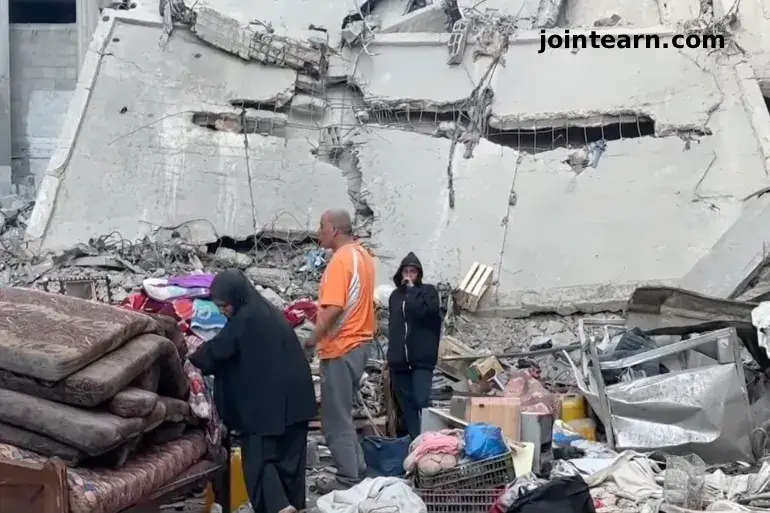
Despite the US-brokered ceasefire between Israel and Hamas, residents of Gaza say they remain trapped in fear, unable to rebuild their lives as Israeli air strikes continue to hit various parts of the besieged territory. What was meant to be a truce has instead turned into a fragile pause overshadowed by renewed violence.
A Fragile Ceasefire Shattered by Ongoing Israeli Strikes
The ceasefire, announced earlier this month under a 20-point plan brokered by the United States, was supposed to bring temporary relief to Palestinians after two years of relentless war. However, frequent Israeli violations have cast doubt over Israel’s commitment to the truce.
On Wednesday, October 29, 2025, more than 100 Palestinians—mostly women and children—were killed, and over 250 others injured in a new wave of Israeli air strikes on southern Gaza, marking the deadliest day since the ceasefire began.
Eyewitnesses reported ten separate air raids on Khan Younis overnight, turning residential areas into rubble. Despite Israel’s claim that its military operations were in response to the killing of an Israeli soldier by Hamas, the Palestinian group denied any involvement in the incident.
Gaza’s Civilian Toll: Thousands Killed, Thousands More Injured
According to the Gaza Health Ministry, at least 211 people have been killed and 597 injured since the ceasefire came into effect on October 10. These attacks come in the aftermath of Israel’s war on Gaza that began in October 2023, a conflict that has killed more than 68,500 Palestinians and injured over 170,000.
Local journalist Hani Mahmoud, reporting for Al Jazeera from Gaza City, described an atmosphere of constant tension and fear.
“While the ceasefire might technically exist, the sounds of drones, gunfire, and explosions remind everyone that peace remains out of reach,” he said.
Life Under Siege: Palestinians Unable to Rebuild
For residents of Gaza, the hope of returning to normal life is fading fast. After surviving months of air raids, many families had just begun to rebuild their homes and businesses when the new wave of attacks struck.
“We’re waiting for a real chance to rebuild,” said Mazen Shaheen, a resident of Gaza City. “Every time we start to pick up the pieces, another strike destroys everything again. We live day by day, never sure if we’ll see tomorrow.”
Others echoed the same despair.
“People believed the war was finally over,” said Hassan Lubbad, another Gaza resident. “But the new bombings shattered that hope. Now, even children wake up terrified, asking when the next explosion will happen.”
‘Where Are the International Guarantees?’
The ceasefire agreement, signed under the mediation of US President Donald Trump’s administration, included provisions for:
- The exchange of Israeli captives for nearly 2,000 Palestinian prisoners.
- A plan for rebuilding Gaza and establishing a new administrative body without Hamas.
However, many Palestinians now question whether these promises mean anything.
“Where are the international guarantees that were promised? Where are the mediators who said they would ensure peace?” asked Shaheen, whose friend was injured in the latest attack.
Civilians have repeatedly appealed to the international community to enforce the ceasefire and end Israeli aggression. But for most in Gaza, those appeals have gone unanswered.
The Psychological Scars of Endless Conflict
The toll of Israel’s ongoing military campaign extends beyond physical destruction. Psychologists and aid organizations warn of a deep mental health crisis among Gaza’s 2.3 million residents, particularly children who have spent most of their lives under blockade and bombardment.
“People in Gaza live with continuous trauma,” Al Jazeera’s Hani Mahmoud noted. “Even during a ceasefire, the fear of another attack is constant.”
Residents describe sleepless nights filled with the hum of drones, the sound of distant shelling, and uncertainty about the future.
“We just want to live in safety,” said Suha Awad, another Gaza resident. “We don’t want a truce that lasts a week or two. We want a complete end to the war — a real, lasting peace.”
The Humanitarian Situation: Gaza on the Brink
The continued air strikes have worsened an already dire humanitarian situation. Hospitals remain overwhelmed and under-supplied, while thousands of displaced families live in makeshift shelters without access to clean water or electricity.
International aid groups have called for immediate humanitarian corridors, but ongoing violence makes the delivery of food, fuel, and medical supplies increasingly difficult.
Despite repeated UN appeals, reconstruction projects remain on hold, leaving much of Gaza in ruins.
What Comes Next for Gaza?
As the ceasefire continues to crumble, international observers warn that the conflict could escalate again if diplomatic efforts fail. Analysts say that without a verifiable monitoring mechanism and international pressure, the truce risks collapsing entirely.
Palestinians in Gaza, however, continue to hold onto hope — however faint — that peace and stability will one day return to their shattered homeland.
“We have lost so much,” said Lubbad quietly. “But we still have our voices, and we want the world to hear them.”


Leave a Reply